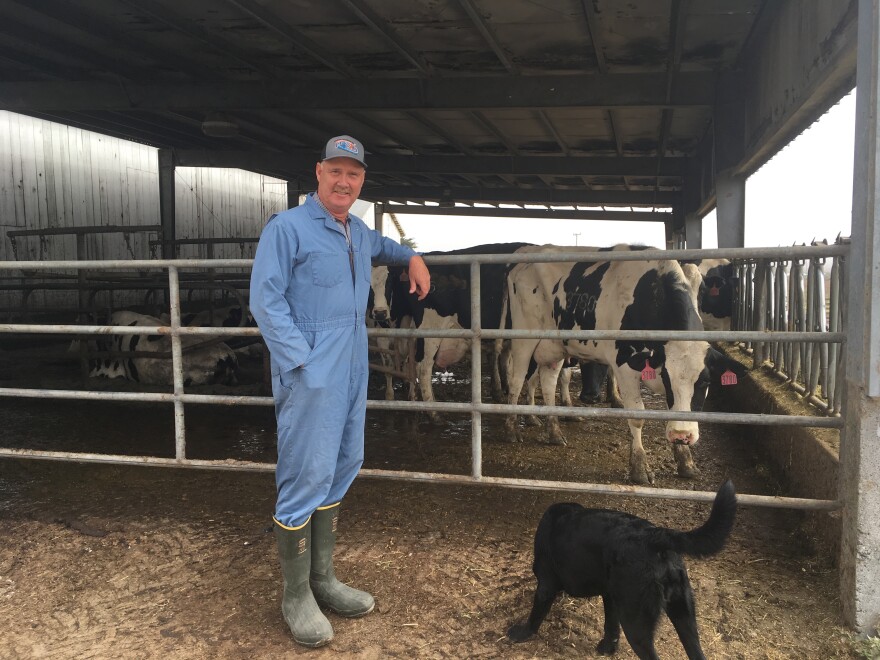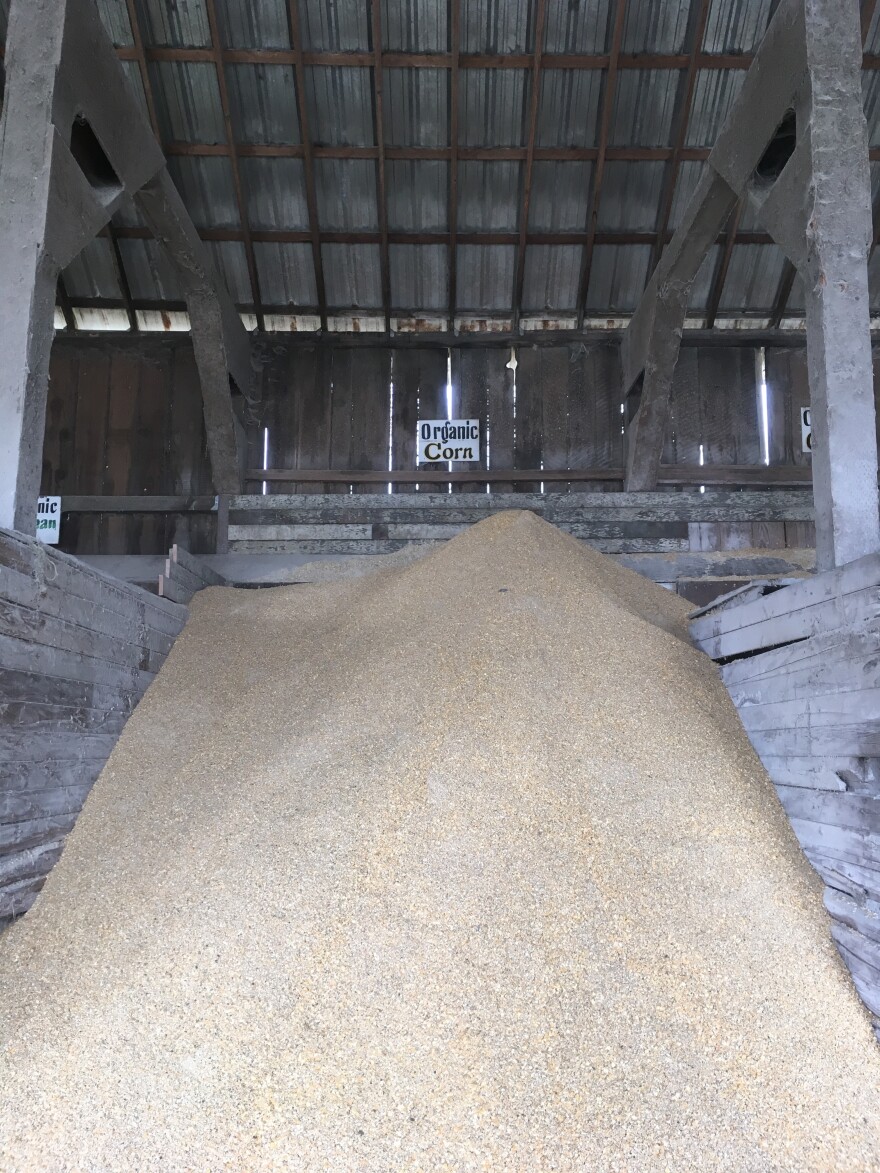Point Reyes National Seashore is one of the few national parks in the country that’s zoned for both agriculture and wilderness. But this uniqueness has also caused a lot of tension, between people who think farms don’t have a place in a National Park, and others who think the elk are out of place.
If you want to get a history of ranching in Point Reyes, you could do a lot worse than talking Robert McClure.
“I am a fourth-generation dairy farmer. I tell people my standard line is, ‘I'm the fourth generation of people not smart enough to do something else,’” he jokes.
The reality is, his family has mastered how to raise and milk cows here. They’ve been dairying in Point Reyes for 130 years - before it was a National Park. There’s even a beach named after his great grandmother, just down the road.

McClure and his dog Opie give me a tour of the ranch and show me a restored barn out back where they used to milk cows by hand. Back then, milk, cream, and butter were shipped to San Francisco by schooner. Now, McClure milks 500 cows and the milk ends up in grocery stores under the Clover brand. It’s one of six remaining small dairies in Point Reyes. They’re all organic. They’ve also all been here way before the national seashore was officially established in 1962.
In the summer, the hills are brown and bad for grazing. So McClure’s old barn is filled with giant heaps of corn, almond hulls and soybean meal ready to be mixed for feed.
“So that’s our big margarita mixer truck with big blades like a blender,” he points out. “We put all of our feed stuff in there and that’s what we feed the cows.”

McClure says he’s kept investing in equipment like this even though his family no longer owns the land. When Point Reyes National Seashore was established, some dairy ranchers sold their land to the park in exchange for leases.
“It was our belief that we would be here for at least as long as we're getting along, and we made significant investments the dairy industry. I mean we put literally millions of dollars into these places.”
Now he’s not sure how much longer he can stay. The National Park Service will soon decide whether to renew the leases for the six dairies and 18 beef ranches in Point Reyes National Seashore. Some environmental groups sued the Park Service to get an environmental impact statement, looking at how these farms affect nature. Now, the Park has to consider a handful of options, ones that keep leasing to ranchers like the McClures and their cows, and ones that could kick them out, and protect other species, like tule elk.
The only national park with tule elk
You can only find tule elk in California. Back in the 1800s they grazed the Point Reyes peninsula just like the cattle do now, but they were hunted out, and most people thought they were extinct. But a small heard was found in Southern California, and many years later tule elk were reintroduced to Point Reyes. Now, if you take a hike in certain areas of the park, you’ll likely see their antlers peeking out of the tall grass and fog.
Dave Press is a wildlife ecologist for Park. We walk through the fields of an abandoned ranch on the western edge of the peninsula, hoping to spot some tule elk. When get a good view of a ridgeline, Press passes me his binoculars.

“There's a couple crossing that fence and you can see a little calf there off in the distance,” Press says as he points to the hill.
An elk and her baby calf are stepping through a barbed-wire fence dividing wilderness from farmland. In theory, the elk are supposed to stay in the wilderness but Press tells me, “they’re going to do what they want to do.”
The elk are wild animals. It doesn’t matter if a fence gets in the way, they’ll go over and under and through it enough... and eventually they’ll knock it down. Farmers hate this. But, the environmentalists who sued the Park don’t think elk shouldn’t be confined. They point to 250 tule elk that died during the last drought.
Prioritizing the natural resources
“So that really set us on a path to looking at how the Park was being managed,” says Deborah Moskowitz, the president of the Resource Renewal Institute. They’re one of the environmental groups that sued the Parks Service.
“What we've found was that it seemed like there was kind of a priority given to making sure that everything worked well for the ranches.” While the elk and other species get the short shrift.
“It's like well what is what is the purpose of a National Park? Is it to prioritize taking care of wildlife, after all where are they going to go?” Moskowitz says.
When the Resource Renewal Institute looked into it further, they discovered the Park’s general management plan hadn’t been updated in decades.
“So you know a lot's happened in the last 38 years - climate change, we know a lot about more about that,” she says. Moskowitz worries about the lack of water for elk, overgrazing by cattle, and the fact that cattle are responsible for a big portion of the greenhouses gases from the park. Another big issue? Point Reyes cows produce more than 100 million pounds of manure each year.
A complicated mission
“I think sometimes people will say ‘well it's your job as the National Park Service to take care of natural resources which is true,’” says Melanie Gunn, the National Seashore’s outreach coordinator. “And it's our job to take care of the cultural resources. So it's a great mission and it's challenging.”

So as part of the lawsuit, the Park agreed to update their general plan and study six different scenarios, including what it would be like if ranching was cut back, or totally out of the picture. But, to be fair to the ranchers, the cultural resource, they also agreed to study what it would be like if elk were gone. Because while the environmentalists see the elk as treasures that need protection, many ranchers also see them as nuisances that damage their fences - like what biologist Dave Press and I observed through his binoculars.
Competing with the cows
There’s concern about competition for forage, so once elk break into pasture, ranchers claim they’ll out-munch their cattle. Then they say they’ll have to start buying feed so their animals don’t go hungry.
“Our current elk plan, which was written in 1998 does not address the presence of elk on ranches, so it doesn't give us a whole lot of guidance on what we should do,” Press says.
They’ve tried to manage the elk in small ways, like hazing them off ranches daily and hoping over time they’ll learn to stay away.
“But we need to consider the big picture. The reality is that seeing tule elk in the Drakes Beach area is a major attraction for folks that come out to the Park,” Press adds.
Kicking out the elk, instead
Neighbors have stakes on both sides of the lawsuit. But, beef rancher Bill Niman’s outspoken.
“It's politically incorrect to say that the elk shouldn't be here,” he says.
Niman’s family hasn’t been ranching in the Park for as long as others, like the McClures, but he’s been extremely successful. He started Niman Ranch here, and he’s now working with the meal kit company Blue Apron. He is confident about the way he manages his cattle. When he calls out to them, they moo back and come trudging up to him.
He says trained them like this so it’s easier to move them around his land, to make sure it isn’t over grazed. So, he doesn’t buy the argument about cows damaging the landscape. Niman tells me he treats the land just as well as he treats his cattle, and consumers like it.
“Will this ranch operation be able to survive or thrive and produce food for human consumption in harmony with the elk? I don't think so,” Niman says.
Since their reintroduction into the Park, the elk have multiplied. They have no natural predators here.
“Unless you're going to introduce grizzly bears and wolves to prey on the elk and keep that herd in balance, or you're going to have Dick Cheney out here hunting with a high powered rifle to reduce the number of elk, if we're not going to take those steps the elk really should not be here,” Niman says.
Most of the Park’s future options involve closely managing the heard, constantly keeping the numbers down, but Niman doesn’t think that’s enough.
“It's not a zoo. It's not a petting zoo. And that's not what we should be trying to create out here.”
A false choice
Other ranchers like Robert McClure think it doesn’t have to be either or. As long elk don’t get onto farms, he thinks they can share the Park with the elk and hopes the Park will land somewhere in between, a sort of managed coexistence.
“It has worked well for almost 50 years, and I've been involved in it almost since the inception of the Park. I remember even when the Park bought the ranches, and we were a little bit apprehensive at first, thinking ‘can this kind of work out?’” McClure says. “But it really has. We can work together. In my opinion it can be a model for environmental concerns, sustainability, all that kind of stuff, and modern viable agriculture. We can do it, we have been doing it.”

McClure starts up an ATV and drives me to a big barn that can house cows in the rainy wintertime, so their manure doesn’t flow into streams.
He says he wants to invest in more technology like this to keep the ranch as sustainable as possible, but with unclear future, he can’t afford it right now. McClure says a future with environmentally friendly farms is not only possible, it’s necessary.
“We have to. We all need to eat. We do.Whether your food choices may be different than mine, we still have to eat. You know your food doesn't come from the store, it comes from a farmer. And once we're gone, we're gone.We're not coming back, you know.”
The National Parks Service is expected to come out with their environmental impact statement shortly. In it, they’ll present their preferred alternative for the future of elk and ranchlands on the seashore. The public will then have 45 days to make comments.


